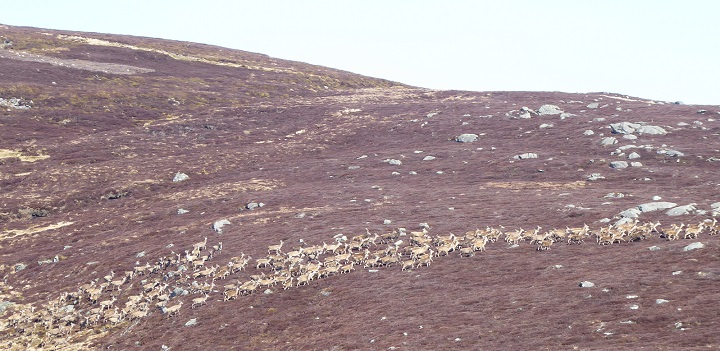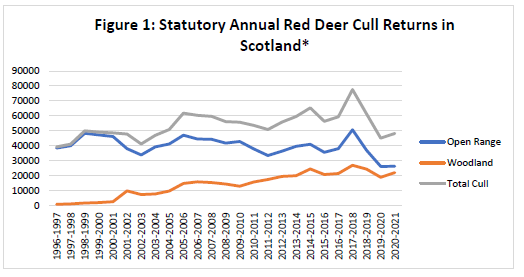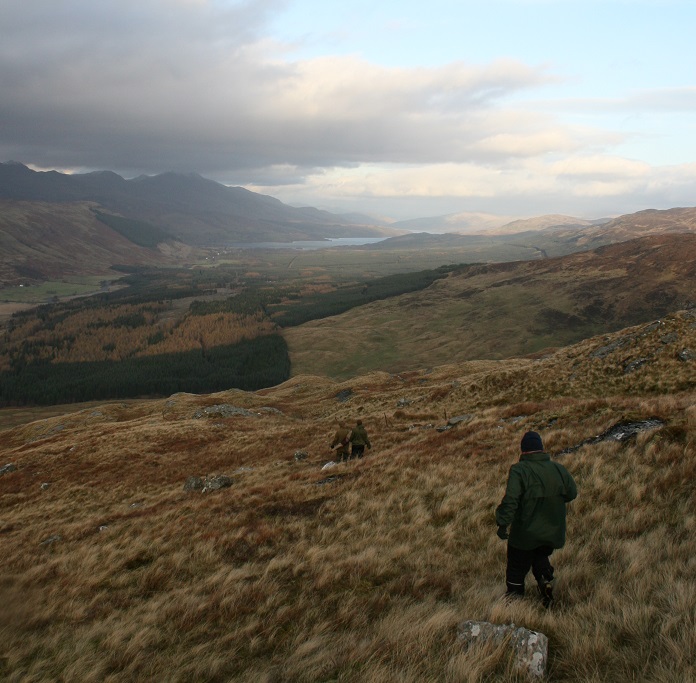
Restoring Scotland’s natural woodland cover and biodiversity from centuries of over grazing is an urgent and necessary step towards sustainable management and care for our hills and mountains. Woodland regeneration could, within decades, extend throughout the uplands allowing a natural woodland mosaic to develop, increasing biodiversity while protecting and enhancing the terrestrial carbon cycles. The most cost-effective way to achieve a natural transition from moorland to woodland at a landscape scale is through sustainable deer management Cost-effectiveness analysis of woodland ecosystem restoration (researchgate.net).
The current voluntary approach to deer management is clearly failing. On moorland and other open ground where native woodland expansion would have the greatest environmental benefit the total number of deer culled on the open hill has been declining over the last 20 years and in fact has never come close to the culling level required to reduce deer numbers and regenerate woodland cover (Figure 1). While some estates have been attempting to increase their cull levels, they are in the minority. For example, a recent study found that around 75% of sporting estates considered ownership of a sporting estate a ‘lifestyle choice’ and wished their estate to be dedicated to sport shooting. The primary management aim on these estates is to maintain sufficiently high deer densities to support recreational stalking for the owner, his friends and elite clients Conservation with a Gun: Understanding Landowner Attitudes to Deer Hunting in the Scottish Highlands (researchgate.net). Needless to say these owners consider woodland regeneration a ‘threat’ to their ‘sport’ and the investment value of their property.
The voluntary approach is, of course, fatally undermined by the perennial recalcitrance of the Scottish Government, via its agency NatureScot, to deploy the more powerful legislative tools at their disposal to ensure even the very modest deer culling targets set by Local Deer Management Groups are met. Recent legal amendments and measures currently being considered or approved such as altering the shooting season for deer and allowing enhanced technology to be used to locate deer are positive developments, but will only apply to the tiny minority of estates who wish to regenerate woodland on their property (or existing woodland owners). Even the introduction of direct financial incentives is unlikely to influence the management of sporting estates as their owners are wealthy and generally subsidise their sporting activities from other sources of income Can Economic Incentives Resolve Conservation Conflict: The Case of Wild Deer Management and Habitat Conservation in the Scottish Highlands (researchgate.net). In essence, woodland recovery at landscape scale is doomed to fail because too many estates pursue traditional sporting objectives and their owners resolutely refuse to cull more deer.

New Legislation is Required
In my view, it is now time to introduce new primary legislation that requires owners of all significant landholdings in Scotland to manage deer to achieve densities that would allow woodland to regenerate, recover and grow New Deer Legislation required (researchgate.net). While these culling targets could be negotiable locally to reflect circumstances, they would be legally binding. Landowners unwilling or unable to meet their legal culling target for different reasons (e.g. seasonal deer movement and/or availability of trained staff) would be able to lease out their quota to neighbouring estates, local community hunting clubs, and game dealers Tradeable hunting obligations – A new approach to regulating red deer numbers in the Scottish Highlands? (researchgate.net).
Deer Management Groups (DMGs) would continue to play an important role in establishing legal cull levels and would allocate quota based on ecological criteria. DMG membership should become more inclusive and representative of the wider range of stakeholders with an interest in deer to help reduce conflict and increase accountability. New members should include local community hunting groups, conservationists and scientists. Representatives of venison producers should also be encouraged to participate to ensure that deer management shifts focus from trophy hunting to venison production. Landowners unwilling to meet their required culling targets through direct shooting or leasing for 3 consecutive years would face stiff financial penalties and the threat of compulsory culling by NatureScot.
With many more deer being shot annually, there will also be additional economic benefits in terms of increased sales of wild venison, which could displace imported and farmed venison. There would also be wider social benefits in terms reduced road traffic deaths and injuries from deer collisions, the need for more professional stalkers and venison processors (all high skilled jobs) and, of course, new opportunities to shoot deer will encourage a new generation of ‘sustainable hunters’ and local community hunting clubs to emerge who can benefit from access to deer stalking (e.g. outdoor exercise, fresh air and their own venison!)

We already know that there is considerable latent demand for deer hunting that is only held back by the lack of opportunities to do so. While I recognise that there may be costs as well, for example in terms of additional labour and possibly a fall in land values as demand for traditional sporting estates ebbs away, these will be transitory due to land acquisition from ‘Green investors’ and local communities.
While the decline of traditional deer stalking introduced will be mourned by some, there is little room for nostalgia or further government procrastination in the current crisis. We need to act now, and with courage, to recover our woodlands and demonstrate we are committed to a sustainable future in our wee corner of the planet.
Aye, how about a National Wildlife SERVICE with powers akin to those of the Federal/state agencies of Canada./United States or something along the lines of the Norwegian system Duncan Halley of NINA has outlined.?
How could we ensure that it wouldn’t be another set of uniformed jobsworths demanding to see your papers and policing the exclusion of the public from ever increasing areas “to protect the wildlife”?
Good point… why not have the wildlife team hired from within the local community….works in other parts of the world
By giving them an appropriate job specification and ensuring that they are properly trained, managed and supervised. It’s not difficult. Other countries do it.
And when it is proved that this can be done here, by fixing exactly this problem in LLTPA, maybe we could consider it. At the moment there is not even official acknowledgement that there is even an issue. Reduction of visitor numbers is policy from the top including total exclusion where possible using nature conservation as an excuse. The US system for one appears to be heavily permit and enforcement based with an added element of “pay to play” within their national and state park system.
I have no doubt the answer to this point is a proper National training regime under clearly defined heirarchy of accountable MANAGEMENT with statutory protocols. The training must engender Knowledge of natural history, public recreation as well as conservation.The duty must be seen as a National Public service.
No room here for individual unfair actions to be localised, blurry, or hidden behind some remote presumption of total authority. (Each official must be fully indentifiable and traceable).
No room in this new “Countryside Ranger SERVICE” , either, for buck-passing of responsibility. The heavy handed club ‘bouncer’ attitude, (in para military uniform …flourescent jacket + hard hat?…)’ increasingly found everywhere else, cannot be part of any proper solution.
We do need to develop a more organised and science led approach. Nature Scot not really geared up for this…we definitely need more educational outreach to help folk understand the issues at stake.
Two quick comments – One is that situations like this occur widely – in the sense that you have a resource like wild deer, cattle, sheep or other will herbivores that are harvested one way or another. Some of these situations are sustainable and some not. What is the difference? There are two basic resources – one it the animal of whatever form that is being harvested and the other is the plant soil resource on which is it all based. Where that is treated as the basic resource and managed accordingly the system is sustainable but where the resource being harvested is treated as the basic resource it is not. Guess which one system prevails in deer forests.
Another is that, under our current system of landownership, long term implications are not necessarily in owners minds. Take my walk up Donside and near the village of Lumsden today. The owners of Clova Estate at Lumsden are coming across from home in Belgium for a month at Christmas. Off to the right on the road there, the owner of Ardhunkart Estate will spend a month there perhaps three times a year from his home in Thailand and the owner of land on Colibargh, he will come from his estate in France for pheasant shooting – which is all the land is run for. Long term interests or local interests? What’s that?
Absolutely. Sporting estates are possibly the worst form of land use any country could wjsh for in terms of sustainability….yet the government and their agencies are keen to oblige at every turn. When an estate degrades peat through running too many deer on the hill, or burn trees regenerating through the Heather it has not considered a crime. They are not fined, instead they are given public grants to make good …
Thanks Douglas. Two updates:
Latest deer cull data is here: https://www.nature.scot/doc/naturescot-deer-census-results (Table 1)
A consultation on new deer legislation is coming in January. From Scottish Government: ‘expect to publish our consultation on our legislative proposals for deer management early in the New Year. We are working to finalise the documents just now with publication anticipated, all going well, in the first two weeks in January (this will not be earlier than 3 January). We expect the public consultation to run for a full 12 weeks and, as I mentioned previously, we’ll be looking to engage with you through workshops and discussions alongside that.’ There is a commitment to address the Independent Deer Working Group recommendations and ‘go beyond’.
Thank you Mike. I look forward to engaging via the forthcomjng consultation. It will be interesting to discover what the vision of the Scottish Government will be for the short and long term and whether the policy tools available are fit for purpose. My view is that legislative and policy changes have been generally positive but only really work for the ‘converted..ie landowners who want to cull more deer . These are often owners with a strong Forestry component. The greatest challenge, and one that no one in Government wants to talk about are the 50% of landowners on the open hill who are simply not interested in culling more deer.
“Recent legal amendments…” e.g. the removal of the closed season for stags, are likely to make things worse, not better. “Sporting” estates will now be able to choose to shoot stags in the hind season (21st of October to the 15th of February), meaning fewer hinds will be culled. Shooting stags has minimal effect on overall deer populations, compared to shooting hinds.
That’s a good point. Not sure what the justification is for that change. Venison might taste a bit better in February compared to August but that’s not going to be the driver